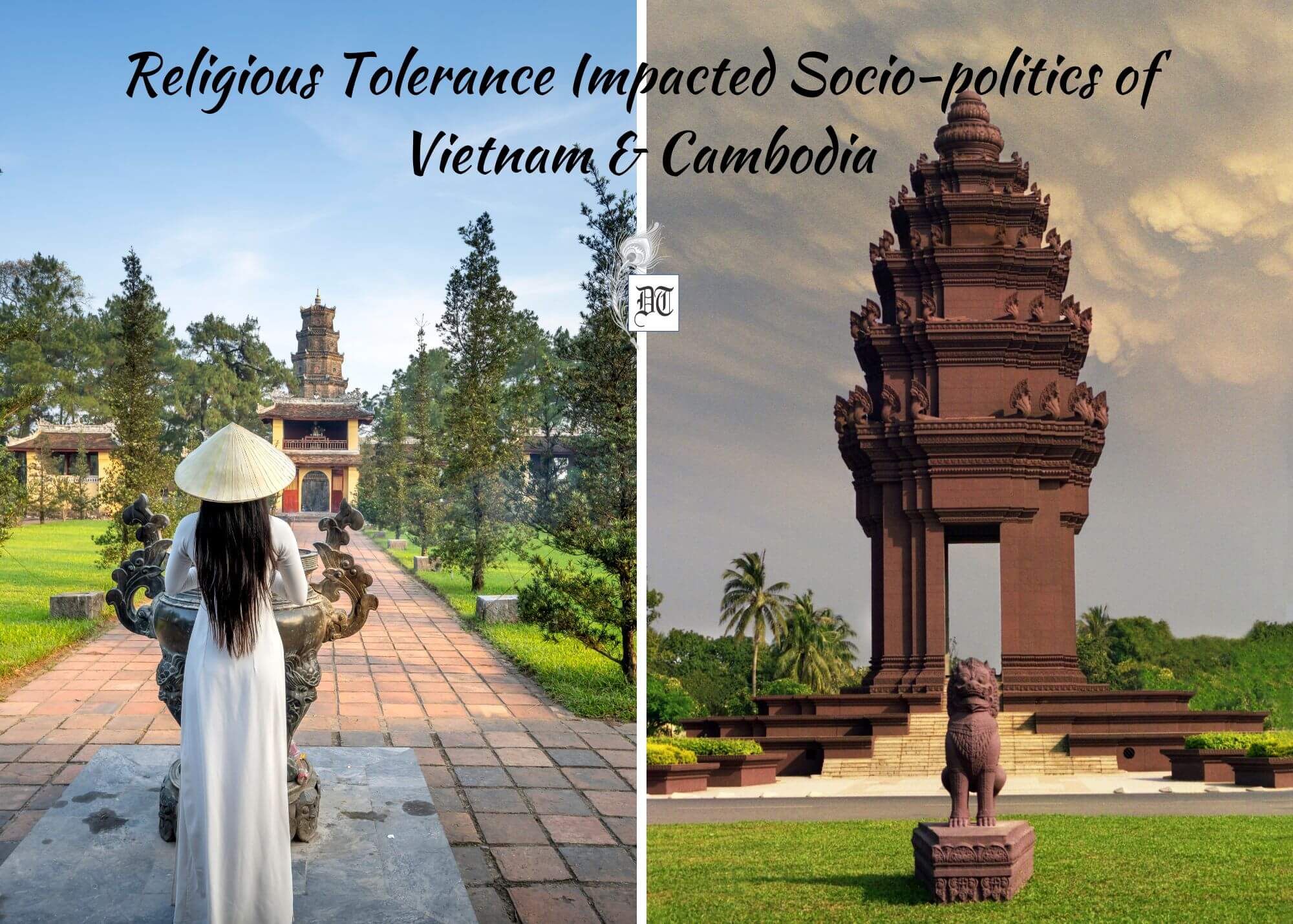Reading Time: 3 minutes
Soumya tells us about the religious tolerance in Vietnam and Cambodia that led to socio-political stability – exclusively for Different Truths.


Vietnam and Cambodia have some fascinating examples of tolerance that can be helpful to examples in our increasingly polarised world.
A 1000-year Chinese rule had deeply influenced the region, and Confucianism and Mahayana Buddhism were the ruling religions, but they incorporated their earlier local gods and goddesses. Later, when Hinayana Buddhism came directly from India, the southern part embraced that. Moreover, the gods and goddesses of the erstwhile Hindu kingdom of Champa were incorporated, and Saraswati, Durga, and Kali are omnipresent in the temples and pagodas.
When the Communists took over, they did not ban religion outright but permitted it to continue as a cultural heritage.
When the Communists took over, they did not ban religion outright but permitted it to continue as a cultural heritage. Much like neighbouring Indonesia, which though Islamic, has retained Hindu traditions as cultural heritage.
Thus, although 70 % of the people declared no religion in the bio, they religiously visit temples and pagodas on the first and 15th of every lunar month and all other auspicious days, have shrines in every home, with all mobiles having both lunar and solar calendars. Offerings at the temples, pagodas, and shrines are used to support the victims of the USA’s chemical warfare, agent orange, affecting even the third generation since the war. Deformed children are born.
As Hindu, Buddhist, and Confucian religions tolerate other faiths and do not have any foreign allegations, they are encouraged.
However, Christians and Muslims, or their spouses, aren’t permitted to join the army, police, and government …
However, Christians and Muslims, or their spouses, aren’t permitted to join the army, police, and government, as their origin is foreign, and allegiance is suspect. Thus, it is tolerance with caution.
In neighbouring Cambodia, it is even more interesting.
An Indian king in the 2nd century ACE, or 2000 years ago, defeated the local tribal cave-dwelling kings who called themselves Nagas, married the princess, and introduced the Brahmanical religion here but incorporated the animist gods native to the region, which always has been the strong point of Hinduism. The entire nation converted to Shaivite Hinduism.
This has an interesting resonance with the Mahabharata story of Arjun defeating a Naga king in the East, marrying his daughter, Lupi, and establishing a kingdom there with Brahmanical traditions. Is history reflected in literature and mythology?
… around the 4th century when an intelligent king introduced Harihara, half Shiva and half Vishnu.
Later, Vaishnavites took over, as in India, and Vishnu temples started replacing Shiva temples. Frequently, the two factions fought till around the 4th century when an intelligent king introduced Harihara, half Shiva and half Vishnu. Then onwards, both deities were worshipped by all, and temples had both idols, along with Ganapati, Durga, and lesser gods like Indra, Kubera, and Varuna.
But Nagas continued being worshipped, and still do, as well as their mortal enemy Garuda, the Vahan of Vishnu.
By then, as in India, Buddhism was in the ascendancy, and a succession of Buddhist and Hindu kings, whenever they replaced each other, would change temples to pagodas and vice versa, replacing the idols inside.
But one bright king found a solution that was least problematic. When this Hindu king took over, he added a third eye to the Buddha statues, thus converting them to Shiva with minimal damage.
So, when a Buddhist king replaced him, all he did was cover the third eye, and Buddha was back.
Around the 14th century, the Hindus had already incorporated Buddha as an incarnation of Vishnu …
Around the 14th century, the Hindus had already incorporated Buddha as an incarnation of Vishnu, the Buddhist king who built Angkor Wat merged the two, and the people, who were now Buddhist, worshipped Vishnu and Shiva and Ganpati. Durga alongside Buddha with equal fervour, and temples and pagodas became one.
An Islamic invasion from the east around this time was defeated with Chinese help, and this ideal tolerance system continued till the colonial rule and survived that too, till the Maoists took over and banned all Religion, destroying images and temples with as much enthusiasm as the Taliban.
But their rule was short-lived; currently, 90 % of people are Buddhists who worship Vishnu and Shiva alongside Buddha with as much devotion and ceremony.
One of the last strongholds of tolerance is the basic tenet of the Indian or Hindu heritage culture and Religion, thriving in this remote country. At the same time, it has struggled to survive in the land of its origin for almost millennia.
Picture design by Anumita Roy













